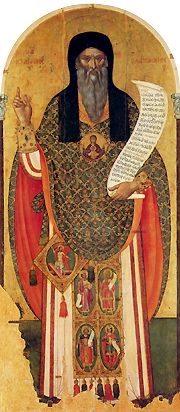Orthodoxy and Western Christianity: Venerating Icons and Saints

Venerating Icons
The Icon FAQ, by Father Deacon John Whiteford. Frequently asked questions about Icons. This is a good place for inquirers to start learning about the Orthodox view of Icons.
Apologia of St. John Damascene Against Those Who Decry Holy Images. This is the classic defense of Icons from the eighth century. St. John was defending Icons during the first half of the Iconoclastic Controversy. His defense was concerned mainly with the accusation of idolatry, as raised from the Old Testament prohibitions. During the second half of the Controversy, the chief spokesman was St. Theodore the Studite. His defense was directed against the monophysite presuppositions behind the iconoclast position. Thus, his defense was Christological—to wit, to deny the use of Icons was to deny the Incarnation. (See On the Holy Icons, by St. Theodore the Studite. St. Vladimir's Seminary Press, 1981).
Presumptuous Propositions, by Timothy Copple and Patrick Barnes. This is an in-depth critique of the Protestant iconoclastic position, focusing especially upon Orthodoxy's ostensible violation of the Second Commandment.
Is Venerating Icons Idolatry?, by Timothy Copple.
Documents of the Seventh Oecumenical Synod in Nicea (787 A.D.) : this Synod was the climax of all the centuries of Christological disputes. By this Synod the meaning of the Incarnation of Christ was given full expression, for She worked out the theological basis for the veneration of Icons from the dogma of the Person of Christ. The presuppositions of the Iconoclasts were Monophysite, and the defenders of Orthodoxy, chiefly St. John of Damascus and St. Theodore of Studios, answered the heretics with Christological arguments. Do my Protestants readers understand this interrelation between the Incarnation and Icons?
Cherubims and Arks, by Timothy Copple.
Old Testament Exegesis on the Hebrew Terms for Prostration and Worship.
Venerating or Praying to the Saints
An Orthodox View of the Virgin Mary: who is She and why do Orthodox Christians "worship" Her?
On the Intercession and Invocation of the Saints, A compilation for Protestants by Reader Christopher Orr.
Why Is Mary Considered Ever-Virgin? Answering the question of a sincere Protestant inquirer.
Documents of the Third Oecumenical Synod (431 A.D.): though many Protestants understand that this Synod was about the condemnation of Nestorius's teaching, few realize that the arguments centered around the use of the term Theotokos, or "Mother of God," for the Blessed Virgin Mary. This was so much the case that Bishop Kallistos (Ware) has written: "The same primacy that the word homoousion occupies in the doctrine of the Trinity, the word Theotokos holds in the doctrine of the Incarnation." (The Orthodox Church, p. 25) So why do Protestants not use the term Theotokos, let alone even honor the Virgin Mary? In not doing so, they in practice deny the Incarnation and fall under the anathemas of the Third Oecumenical Synod. Food for thought.
Related articles in General Info & Topics: The Veneration of Saints & Their Relics.

